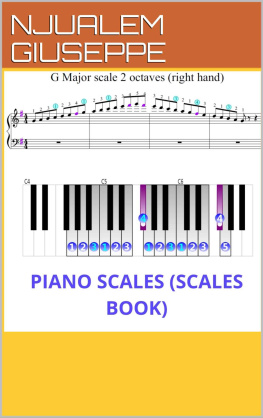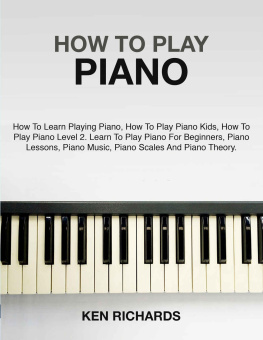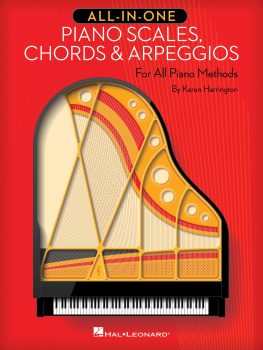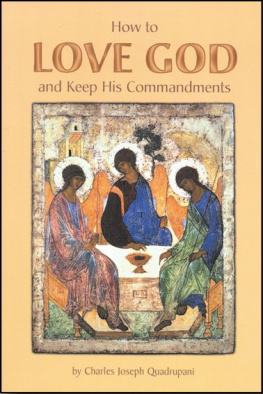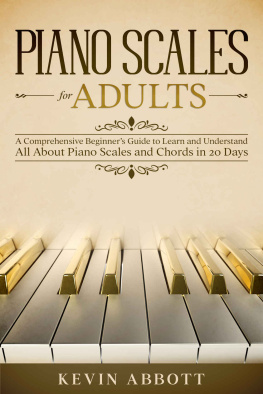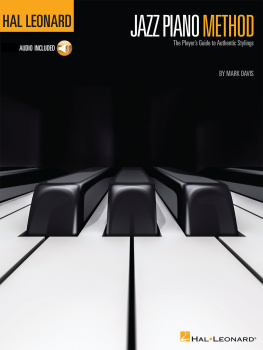Njualem Giuseppe - Piano Scales
Here you can read online Njualem Giuseppe - Piano Scales full text of the book (entire story) in english for free. Download pdf and epub, get meaning, cover and reviews about this ebook. year: 2021, genre: Romance novel. Description of the work, (preface) as well as reviews are available. Best literature library LitArk.com created for fans of good reading and offers a wide selection of genres:
Romance novel
Science fiction
Adventure
Detective
Science
History
Home and family
Prose
Art
Politics
Computer
Non-fiction
Religion
Business
Children
Humor
Choose a favorite category and find really read worthwhile books. Enjoy immersion in the world of imagination, feel the emotions of the characters or learn something new for yourself, make an fascinating discovery.
- Book:Piano Scales
- Author:
- Genre:
- Year:2021
- Rating:4 / 5
- Favourites:Add to favourites
- Your mark:
- 80
- 1
- 2
- 3
- 4
- 5
Piano Scales: summary, description and annotation
We offer to read an annotation, description, summary or preface (depends on what the author of the book "Piano Scales" wrote himself). If you haven't found the necessary information about the book — write in the comments, we will try to find it.
Piano Scales — read online for free the complete book (whole text) full work
Below is the text of the book, divided by pages. System saving the place of the last page read, allows you to conveniently read the book "Piano Scales" online for free, without having to search again every time where you left off. Put a bookmark, and you can go to the page where you finished reading at any time.
Font size:
Interval:
Bookmark:
Contents
The language of the piano is different from all other languages in that: It is spoken by the hands (with the help of the fingers), other than the mouth. So lets turn our attention to our hands, and see which hand says what
Now, as we must have discovered, the language of the piano is divided into 2 ranges (call them dialects), each of the ranges meant to be taken up by a specific hand.
From C4 going rightwards is called the Treble section, and that is because every note found there is found in the portion of the staff that has the Treble Clef.
And from C4 going leftwards, is called the Bass section, and that is because every key found there, is found in the section of the Grandstaff that carries the Bass clef.
Basically, Treble means high notes and Bass means Low notes. So all the high notes on the piano are found in the treble register, while the low notes are found in the Bass register.
The Treble clef is usually called the right hand clef, while the Bass clef is called the left hand clef; this is so because every note written in the Treble section of the piano, from C4 (middle C) going rightwards, is to be played by the right hand (R.H); while all notes written in the section of the Grandstaff that has the Bass clef, down from C4, is to be played by the left hand (L.H). So 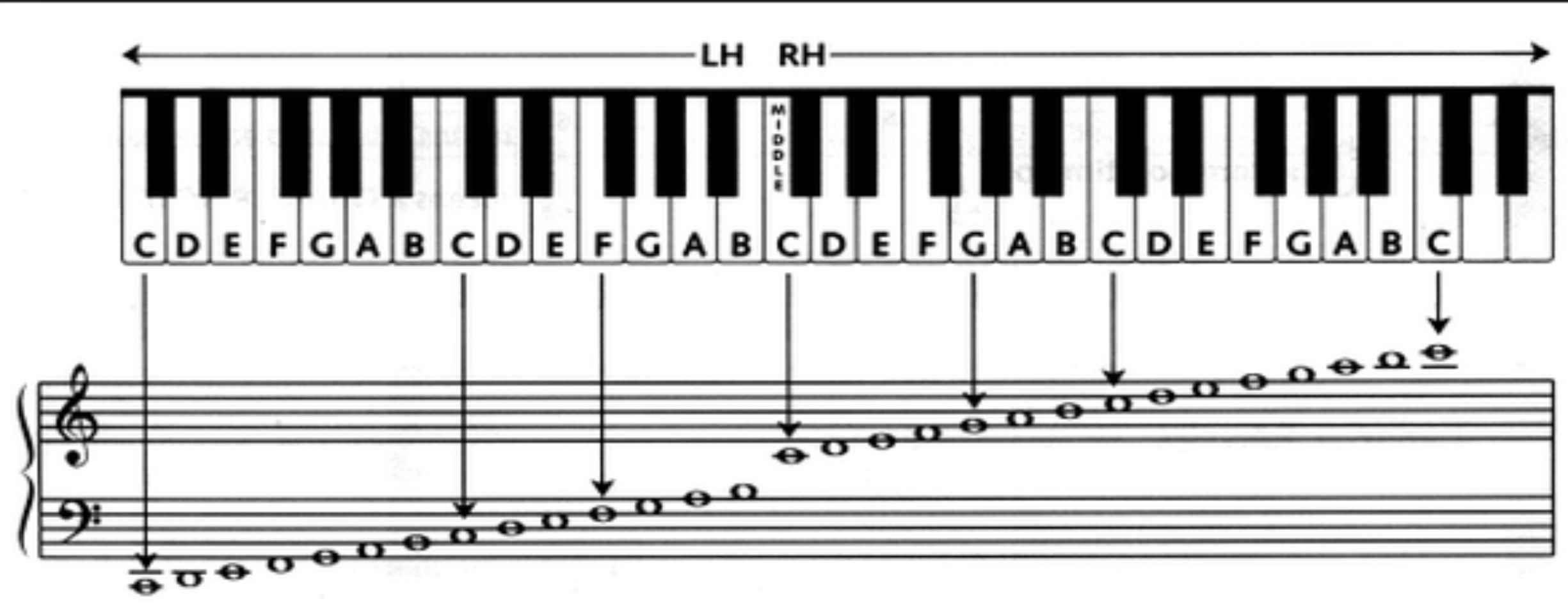 keep that in mind while we fudge ahead.
keep that in mind while we fudge ahead.
Now, we are introduced to a new concept called Scales. A scale is basically a series of notes (usually 8 in number) that starts and ends on the same key (called the Tonic), following a particular formula.
The scale that we use 98% of the time in musical composition is called THE MAJOR SCALE . And the perfect thing is: this scale has a very simple formula: W-W-H-W-W-W-H. Where W= Whole Step, and H= Half Step
In the piano when we say we move a Half Step, it means we move from one note to the immediate next note, be it a white or a black note. For instance, a Half Step from C leads us to a C#, and a Half Step from E leads us to an F.
A whole Step, on the other hand, is when we move from one note, skip the immediate next note, and play the next. For instance, a Whole step from C leads us to D, and a Whole step from D leads us to E.
So the Major Scale formula says we move Two Wholesteps, One Halfstep, Three Wholesteps, and One Halfstep. That is: W-W-H-W-W-W-H.
So if we apply it to get the Major scale of C, we begin by playing or writing down the note C, then apply the formula from there. So a whole step from C leads us to D, another Whole step from D leads us E, a Half Step from E leads us to F, a Whole Step from F leads us to G, another Whole step from G leads us to A, a Whole step from A leads us to B, and a Half step from B leads us to C.
So from applying the Major Scale formula above, C Major Scale comprises of the notes: C-D-E-F-G-A-B-C. ( Sounds familiar?) This is demonstrated below:
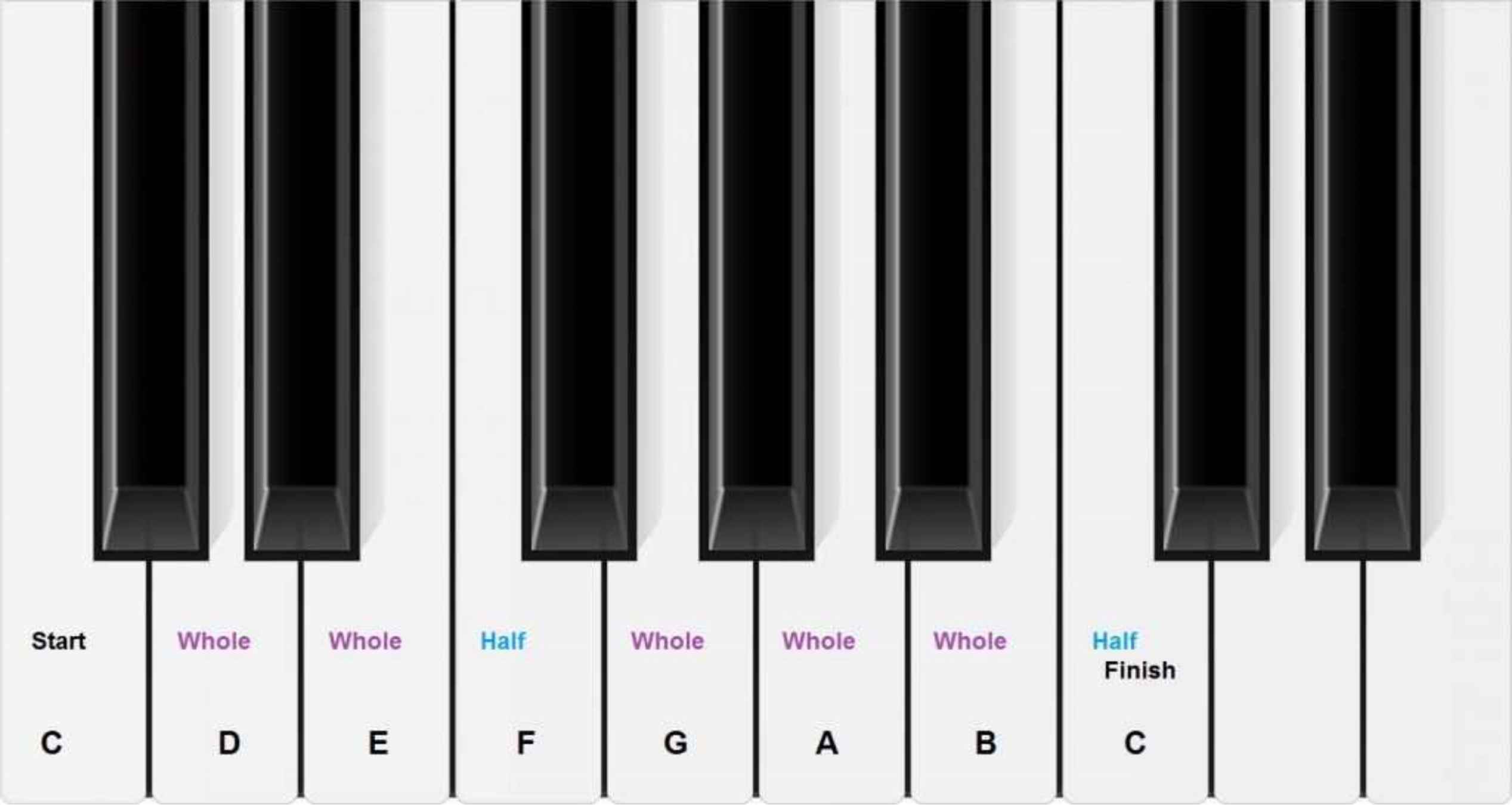
Just as I said in the definition of a Scale, it must always begin and end on the same note (called the Tonic). So the D major scale will begin and end on the note D.
We can use the Major Scale Formula above to figure out all the 12 major scales (That is because each key has its scale, whether naturals or accidentals). However, I will handle the scales with you in a way that makes it easier for you to play Music. So lets kick of
For this lesson, Im going to introduce you to the Circle of Fifths (5ths); an amazing musical concept that will make the whole issue of scales and keys very easy.
THE CIRCLE OF FIFTHS (5ths)
This concept will not only help us understand Scales, but will demystify the whole issue of Key Signature. Below is the Circle referred to as the Circle of Fifths.
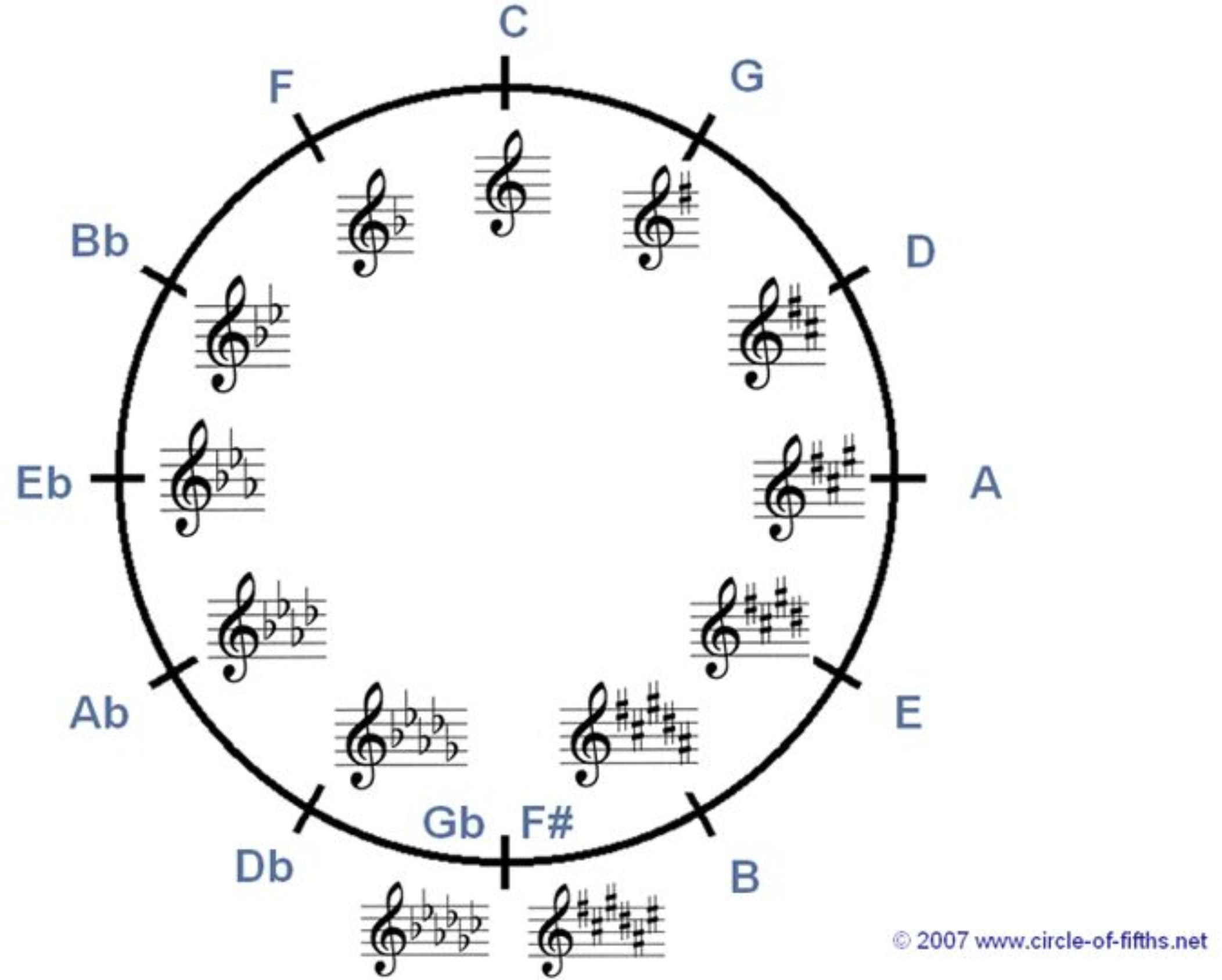
C Major is considered as the starting point of the circle; and the line that divides the circle into 2 equal parts cuts across C (up) and F# (down), and from C going rightwards (that is from G to F#), we have the Sharps Section (made up of: G, D, A, E, B, F#); while from C going leftwards, we have the Flats Section) (made up of: F, Bb, Eb, Ab, Db
The Circle is called the Circle of Fifth because the distance from each note, in the circle, to the next note is a Perfect Fifth Interval.
A Perfect Fifth interval is the same like 7 half steps. So from C, if you count 7 half steps (not counting C as one), it will lead you to G; and counting 7 Half Steps from G (not counting G as well) leads you to D, and so on
Two very easy mnemonics that will help you memorize the Circle of Fifths forever
From C to F# (that is the Sharps section towards the right): C ailly G ets D runk A nd Eats B utter F lies
From C to Db (that is the flats section towards the Left): C ailly F ixes BEAD ( That is: C-Fb-Bb-Eb-Ab-Db) .
Lets get to one of the reasons why I introduced this Circle here
The Circle of Fifths is a great helper when it comes to figuring out the notes that are added to a given scale; that is, it helps us figure out notes within Scales.
C major which is considered as the starting point of the Circle, as a Major Key, has no sharp and no flat in its Major Scale. The Major Scale of C Major is, therefore, made up of the notes: C-D-E-F-G-A-B-C , which of course respects our Major Scale Formula.
From C Major going to the right, sharps (accidentals) start adding to give us major scales. So the key of G has 1 sharp, the key of D has 2, The key of A has 3, E has 4, B 5, and F# 6.
It, therefore, becomes a pain figuring out which sharps which key has. Its with this in mind, Folks, that I will show you an interesting function of the Circle of Fifths.
The sharp that adds is a half step behind the key we are figuring out its scale.
The C Major Scale was all natural notes; however, we said Key G Major, which is immediately after C, has 1 sharp. So what sharp is that??
Well, the sharp that adds is a Half Step down (or behind) G; that is F#. So the Scale of G is exactly the same notes as the Scale of C but that the F is sharpened. Is that not easy Folks?? So the scale of G Major is made up of the notes: G-A-B-C-D-E-F#-G.
Likewise we said the key of D Major has 2 sharps, and the sharp that adds is a Half step down D; that is C#. So D major retains the scale of G, but that the C is sharpened. So the scale of D Major is made up of the notes: D-E-F#-G-A-B-C#-D.
So in the key of A Major, what sharp adds? Of course it is G#, which is a Half Step behind A. So it retains the F# from G Major, retains the C# from D Major, and adds its G#. So it is exactly same scale as D, but that the G is Sharpened: A-B-C#-D-E-F#-G#-A.
So too is the key of E Major-The sharp that adds is D#. So it is exactly the same scale like A Major, but that the D is sharpened. I guess you can see how simple this concept of scales is with the help of our circle.
So in the key of B Major, which new sharp adds? You got it correct: A# adds. So, B is exactly the same as E Major, but for the added A#.
And finally, in the key of F# what sharp do you think will add, since weve exhausted all the Black keys? Well, we maintain our formula and move a Half step down F#. That leads us to E# . Yes, In this key, F is referred to as an E# (remember its immediately to the right of E).
So the F# major Scale is exactly the same like the B Major Scale, but for the added E#. So the F# Major Scale is made up of the notes: F#-G#-A#-B-C#-D#-E#-F#
Font size:
Interval:
Bookmark:
Similar books «Piano Scales»
Look at similar books to Piano Scales. We have selected literature similar in name and meaning in the hope of providing readers with more options to find new, interesting, not yet read works.
Discussion, reviews of the book Piano Scales and just readers' own opinions. Leave your comments, write what you think about the work, its meaning or the main characters. Specify what exactly you liked and what you didn't like, and why you think so.

